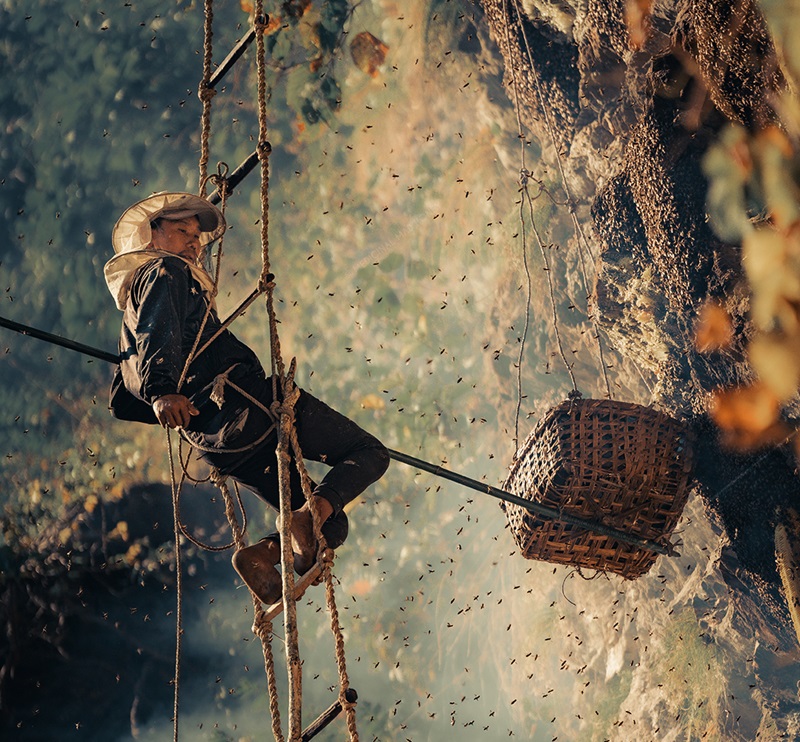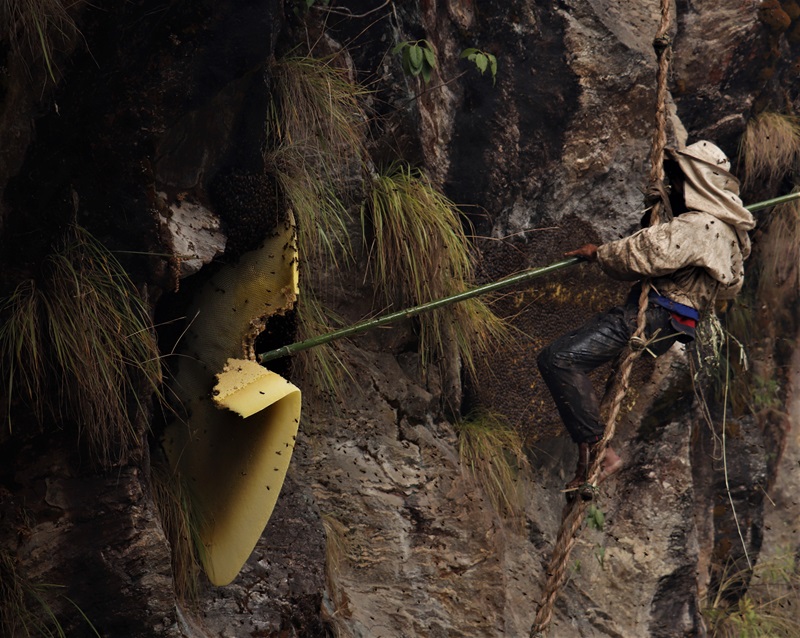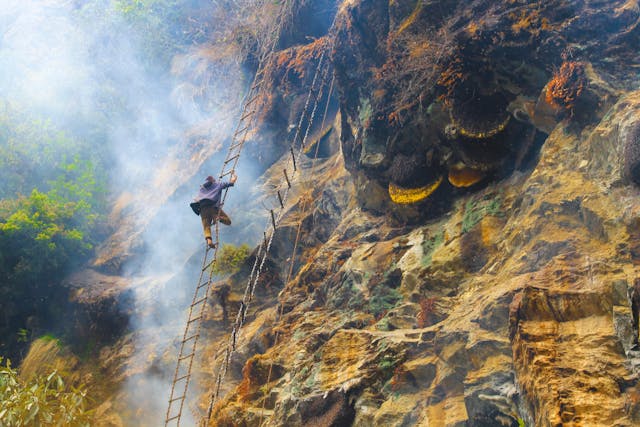The (Apis laboriosa), the world’s largest honeybee, is vital for the high mountains of Nepal, Bhutan, and northern India.
These Himalayan giant bees pollinate mountain plants like rhododendrons and junipers, helping the forests stay healthy and diverse. Their rare “mad honey,” gathered by the Gurung people, supports both nature and local tradition.
Protecting these bees means protecting the mountain’s balance — and the people who depend on it.

The Cliffside Guardians of the Himalayas
High above green valleys, men climb rope ladders along steep cliffs. Clouds of bees buzz around them as they collect golden honey from hives the size of shields.
These honey-hunters are the Gurung people, keeping alive a skill passed down for centuries. The bees they seek — the Himalayan giant bees — live higher than any other honeybee on Earth. Their story connects nature, culture, and survival.
Masters of the High Altitude

The Himalayan giant bee can grow up to three centimeters long — much larger than common honeybees. It survives where few insects can, between 2,500 and 3,500 meters above sea level.
They build their large hives under rocky ledges that face the sun but stay safe from strong winds and rain.
Their honey, known as “mad honey,” comes from rhododendron flowers. These flowers contain natural compounds that make the honey slightly hallucinogenic and medicinal. For generations, people have used it in small amounts to ease pain and lower blood pressure. Modern experts, however, advise care — too much can be harmful.
Inside the Hive: How Himalayan Giant Bees Adapt to the Extremes
Each hive of Apis laboriosa holds thousands of hardworking bees that survive in thin, cold air. They save energy by flying slowly and foraging carefully. When winter comes, they move from high cliffs down to warmer forest areas.
Unlike their lowland cousins (Apis dorsata), these bees can handle freezing nights and low oxygen—almost 40% less than at sea level. Their thick hair keeps them warm, and by vibrating their wings together, they can heat the hive from within.
Scientists studying these bees in Nepal’s Kaski District found that they can fly up to 5 kilometers to gather nectar, helping plants across wide mountain areas.
Pollinators That Hold Mountains Together
In high mountain air, pollination is hard. But these bees make it possible. They help flowers like rhododendrons, primulas, and junipers grow and spread.
Their work keeps meadows and forests healthy. In turn, this supports birds, small animals, and even the soil itself.
Experts from ICIMOD and WWF Nepal warn that without these bees, many mountain plants would stop regenerating. That would lead to more erosion, less carbon storage, and a weaker mountain ecosystem.
Ancestral Art: The Gurung Honey-hunting Tradition

Each spring and autumn, the Gurung people of Nepal gather for their traditional honey harvest. Climbers scale cliffs as high as 300 feet using bamboo ladders and long poles with baskets at the end. Smoke calms the bees before part of the honeycomb is cut and lowered.
This ancient practice shows respect for nature. Hunters take only part of each hive, leaving enough for the bees to rebuild. This balance keeps both people and bees thriving year after year.
From Cliff to Commerce: The Global Journey of Mad Honey
Mad honey, once a local treasure, now travels the world. Buyers in Japan, Korea, and Europe pay high prices — sometimes over $100 per kilogram — for real Himalayan honey.
But this fame brings problems. Some harvesters take too much, fake products appear on the market, and middlemen often underpay local collectors. To protect both bees and people, Nepal’s Wild Honey Trade Guidelines now set fair trade rules and export standards.
Groups like WWF Nepal and the FAO help local cooperatives manage harvests together. Their goal is simple: keep honey collection fair, traceable, and sustainable.
Climate Pressures and Fragile Futures

The bees’ mountain homes are under threat from climate change. Warmer temperatures shift flower seasons and push colonies higher into the mountains, leaving fewer safe places to build hives.
In districts like Lamjung and Kaski, locals say hive numbers have fallen by 20–30% in the last 20 years. Causes include deforestation, tourism growth, and changing weather.
If this continues, both the bees and the ancient honey-hunting traditions could disappear within a generation.
Conservation at the Edge: Protecting Bees and Communities Together
Saving Apis laboriosa means blending science with local wisdom. Conservationists and villagers are working side by side to:
- Protect cliffs used for nesting through community-managed zones.
• Replant rhododendron forests, the bees’ main nectar source.
• Set eco-tourism guidelines to reduce disturbance near hives.
• Use drones and citizen science to track bee colonies safely.
Projects like the Himalayan Bees & Livelihoods Project (run by ICIMOD and Tribhuvan University) bring all these efforts together. They connect tradition with modern tools to protect both bees and the people who rely on them.
Honey-hunting Tourism: A Blessing or a Burden?
Tourists now travel to mountain cliffs to watch Gurung honey hunters at work. While this brings money to remote villages, it also risks disturbing bee colonies and turning a sacred tradition into a show.
Unregulated visits can harm both nature and culture. To prevent this, some local councils plan to issue permits that limit visitor numbers and share income with conservation funds. This system aims to balance tourism benefits with respect for bees, people, and heritage.
“We Climb for the Spirits”: Voices from Nepal’s Honey Hunters
For many Gurung elders, honey-hunting is as spiritual as it is physical. “We climb for the spirits,” one honey hunter told a WWF researcher. “The cliffs belong to the bees — we only borrow from them.”
But as young generations migrate to cities, the number of active hunters is shrinking. Without apprentices, this ancient knowledge could fade, leaving both bees and beliefs unprotected.
Bees Beyond Borders: Why the World Needs Himalayan Pollinators
Globally, three-quarters of food crops depend on pollinators, yet bee populations are collapsing under pesticide use, disease, and habitat loss.
While Western honeybees face colony collapse disorder, Apis laboriosa faces a quieter crisis — a shrinking sky. Their survival offers lessons for sustainable coexistence between humans and wild pollinators worldwide.
UN-backed reports like the IPBES Pollinator Assessment highlight that local stewardship models, like those of the Gurung, may be crucial templates for protecting global biodiversity.
Innovation Meets Tradition: New Science for Old Wisdom
New technologies are helping bridge traditional practice and modern research.
- Drones and AI mapping track hive locations and density.
- Remote sensors measure microclimate shifts in cliff ecosystems.
- Bio-assays are used to study grayanotoxin levels for medicinal use.
Scientists and communities are now working side by side — blending ancient harvesting skills with scientific data — to ensure Apis laboriosa survives the next century.
Himalayan Giant Bee at a Glance
| Feature | Detail |
| Scientific Name | Apis laboriosa |
| Habitat Altitude | 2,500–3,500 meters |
| Hive Size | Up to 1.5 meters wide |
| Honey Type | “Mad honey” (grayanotoxin-rich) |
| Key Floral Sources | Rhododendron, Primula, Juniper |
| Key Regions | Nepal, Bhutan, Northern India |
| Conservation Status | Data Deficient (IUCN, 2023) |
A Delicate Balance Between Humans and Nature

For the Gurung people, honey-hunting is more than a job — it is a way of life.
Each harvest shows deep respect for nature. Hunters take only what they need and leave enough for the bees to recover.
This balance keeps both people and the wild in harmony.
Protecting Apis laboriosa means protecting biodiversity and the culture that depends on it. It reminds us that true sustainability includes people, traditions, and the planet.
Conclusion
The Himalayan giant bee is not just an insect. It is a builder of mountain life and a link between humans and nature.
As the world changes fast, its story teaches an old truth: lasting sustainability grows from respect, patience, and balance.
Sometimes, the best lessons for the future come from traditions that already knew how to live gently with the Earth.




